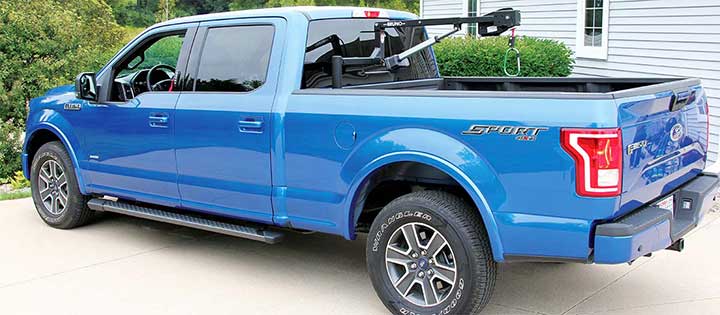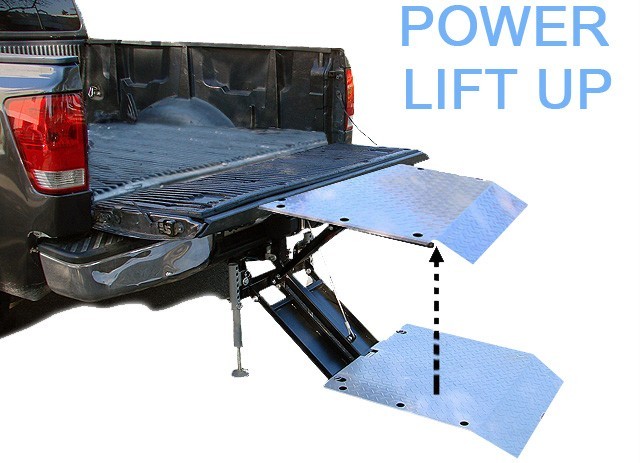Lifts For Pickup Trucks: Elevate Your Ride, Expand Your Horizon pickup.truckstrend.com
For many pickup truck owners, the stock factory height is merely a starting point. Whether driven by a desire for a more aggressive stance, enhanced off-road prowess, or the ability to accommodate larger, more capable tires, the decision to install a lift kit is a transformative one. A "lift for pickup trucks" refers to the modification of a truck’s suspension or body to increase its ground clearance and overall height. This modification not only alters the vehicle’s aesthetic appeal but significantly impacts its functional capabilities, unlocking new levels of adventure and utility.
From navigating challenging trails to simply standing out in a crowded parking lot, lifting a pickup truck is a popular customization that blends form and function. This comprehensive guide will delve into the world of truck lifts, exploring their types, benefits, critical considerations, and what you need to know before taking the plunge.
Lifts For Pickup Trucks: Elevate Your Ride, Expand Your Horizon
Why Lift Your Pickup Truck? The Benefits Unveiled
The reasons behind lifting a pickup truck are as diverse as the truck owners themselves. However, several key advantages consistently drive enthusiasts to elevate their rigs:
- Enhanced Off-Road Capability: This is arguably the primary driver for many. Increased ground clearance means a reduced risk of scraping the undercarriage on rocks, stumps, or uneven terrain. Better approach, departure, and break-over angles allow the truck to climb steeper obstacles and descend challenging declines without damaging bumpers or the frame.
- Accommodation for Larger Tires: A taller truck can fit bigger tires, which are crucial for off-road performance. Larger tires offer a greater contact patch, improved traction, and additional ground clearance. They also significantly enhance the aggressive, rugged look many truck owners desire.
- Improved Aesthetics and Stance: A lifted truck often presents a more imposing and assertive appearance. The elevated ride height, combined with larger tires, gives the vehicle a distinct, custom look that stands out from stock models.
- Better Visibility: While not universally true for all drivers, some find that the elevated seating position in a lifted truck provides a commanding view of the road and surrounding terrain, potentially aiding in spotting obstacles or traffic.
- Increased Payload/Towing Stability (with proper setup): While excessive lift can sometimes negatively impact towing, a well-designed lift kit can enhance stability, especially when hauling heavy loads or towing trailers, by reducing sag and improving weight distribution.

Types of Lift Kits: Choosing Your Elevation
Not all lift kits are created equal. They vary significantly in their design, complexity, cost, and the way they achieve lift. Understanding the different types is crucial for making an informed decision.
1. Leveling Kits
- Description: These are the most basic and least expensive form of lift. Leveling kits primarily aim to raise the front of the truck to match the factory rake (the slight downward slope from rear to front designed for towing/hauling). They typically provide 1-3 inches of lift.
- How They Work: For independent front suspension, they use coil spacers or new strut assemblies. For solid front axles, they might use new coil springs or leaf spring add-a-leafs.
- Pros: Inexpensive, easy to install, corrects factory rake, allows for slightly larger tires (usually 33 inches).
- Cons: Minimal ground clearance gain, can sometimes stiffen the front ride, does not significantly improve off-road capability beyond tire clearance.
- Best For: Truck owners primarily seeking an aesthetic improvement, a level stance, and the ability to fit a slightly larger tire without major modifications.


2. Body Lifts
- Description: Unlike suspension lifts, body lifts do not modify the truck’s suspension components. Instead, they use spacers or blocks inserted between the truck’s body and its frame, effectively raising the body shell while the frame, suspension, and driveline remain at stock height. They typically offer 1-3 inches of lift.
- How They Work: Spacers are installed on the body mounts, and steering shaft extensions, bumper relocation brackets, and sometimes radiator drop brackets are added to accommodate the new height.
- Pros: Relatively inexpensive, easier to install than suspension lifts, retains factory ride quality, minimal impact on suspension geometry or driveline angles.
- Cons: No gain in ground clearance for the differentials or lowest parts of the frame, can create an unsightly gap between the frame and body, can expose more of the frame and wiring, and may require bumper modifications.
- Best For: Those looking for a cost-effective way to fit larger tires and achieve a taller look without affecting ride quality or complex suspension changes.
3. Suspension Lifts
- Description: These are the most comprehensive and effective lift kits, designed to increase ground clearance by modifying or replacing components of the truck’s suspension system. They typically provide 2 inches of lift or more, often up to 6 inches or even higher for extreme builds.
- How They Work: Suspension lifts involve a variety of components depending on the truck’s suspension type:
- Independent Front Suspension (IFS): Often includes new coil-overs, longer control arms (upper and lower), drop spindles, differential drop brackets, and sometimes longer driveshafts.
- Solid Axle Front/Rear: Involves new leaf springs, coil springs, longer shock absorbers, control arms (for coil-sprung axles), track bars, and extended brake lines.
- Pros: Significant increase in ground clearance, allows for much larger tires (35+ inches), can improve suspension articulation and ride quality (with quality components), enhances off-road capability.
- Cons: More expensive, complex installation, can alter suspension geometry (requiring re-alignment and sometimes additional components like re-gearing or driveshaft modifications), potential impact on warranty.
- Best For: Serious off-road enthusiasts, those needing maximum ground clearance, or anyone wanting a truly custom and capable build.
Key Considerations Before Lifting Your Truck
Lifting a pickup truck is a significant modification that goes beyond just adding height. Careful planning and understanding potential implications are crucial.
- Budget: This isn’t just about the lift kit itself. Factor in professional installation (if not DIY), new tires, wheels (often required for proper offset), and potential driveline modifications (re-gearing, driveshafts).
- Intended Use: Will your truck be a daily driver, a weekend warrior, or a dedicated off-road machine? This dictates the type and height of lift you need. A 6-inch lift on a daily driver can be cumbersome, while a 2-inch leveling kit won’t cut it for serious rock crawling.
- Tire Size: What tire size do you realistically want to run? This decision should often come before choosing a lift height, as the tires will dictate how much lift is truly necessary.
- Ride Quality: A poorly designed lift kit can severely degrade ride quality, making your truck harsh and uncomfortable. Research reputable brands known for maintaining or even improving ride comfort.
- Installation Complexity: While leveling kits can often be a DIY project, full suspension lifts require specialized tools, mechanical expertise, and a proper alignment afterwards. Consider professional installation for complex kits.
- Drivetrain and Steering Geometry: Lifting changes angles. For independent front suspension, higher lifts can put stress on CV joints. For solid axles, driveshaft angles might require correction. Steering components may need to be extended or replaced to maintain proper geometry and safety.
- Legality and Warranty: Check local laws regarding maximum lift height and tire protrusion. Also, be aware that significant modifications can potentially void parts of your factory warranty.
- Associated Costs & Modifications:
- Re-gearing: Larger tires effectively change your truck’s final drive ratio, leading to reduced power, slower acceleration, and worse fuel economy. Re-gearing the differentials restores performance.
- Brake Upgrades: Larger, heavier tires require more stopping power. Consider upgrading brake rotors and calipers.
- Speedometer Recalibration: Larger tires will throw off your speedometer and odometer readings.
- Fender Trimming: Sometimes necessary to prevent tire rubbing, especially during suspension compression or turning.
Practical Advice and Actionable Insights
- Do Your Homework: Research specific lift kits for your truck model and year. Read reviews, watch installation videos, and join online forums to learn from others’ experiences.
- Quality Over Quantity: Don’t chase the cheapest lift. Investing in a reputable, well-engineered kit from a known brand (e.g., BDS, Fox, Rough Country, Fabtech, Pro Comp, Rancho) will pay dividends in safety, performance, and longevity.
- Consider Professional Installation: Unless you have significant mechanical experience, the right tools, and a safe workspace, professional installation for full suspension lifts is highly recommended. It ensures proper alignment, torque, and safety.
- Plan for Post-Installation: Schedule a professional wheel alignment immediately after installation. Re-torque all bolts after the first 500 miles. Be aware of changes in driving dynamics, especially a higher center of gravity.
- Don’t Over-Lift for Daily Driving: While a towering truck looks cool, excessive lift can make daily driving cumbersome, impact fuel economy significantly, and make parking garages or drive-thrus inaccessible. Balance aesthetics with practicality.
Price Table: Lifts For Pickup Trucks (Estimated Costs)
Please note: Prices are highly variable based on truck make/model, brand, lift height, and region. These are estimates for the kit only, excluding installation unless specified.
| Lift Type | Lift Height (Approx.) | Estimated Kit Cost Range | Typical Components/Features |
|---|---|---|---|
| Leveling Kit | 1-3 inches (Front) | $100 – $400 | Spacers (coil, strut, torsion key), longer shocks (sometimes), hardware. |
| Body Lift Kit | 1-3 inches | $200 – $600 | Body blocks/spacers, steering extension, bumper brackets, hardware. |
| Basic Suspension Lift | 2-4 inches | $500 – $1,500 | Lifted coil springs, longer shocks, add-a-leafs, blocks, extended links, drop brackets. |
| Premium Suspension Lift | 4-6+ inches | $1,500 – $4,000+ | New coil-overs, control arms, leaf springs, specific knuckles, differential drop, full shock sets. |
| Extreme Off-Road Suspension | 6+ inches (Custom) | $4,000 – $10,000+ | Custom fabricated components, long-travel shocks, bypass shocks, full axle swaps, custom driveshafts. |
| Professional Installation Cost | Varies by Kit/Shop | $400 – $1,500+ | Labor for installation, initial alignment. (Does not include tire mounting/balancing). |
| Related Costs (Estimated) | |||
| New Tires | $800 – $2,500+ | For 33-37 inch tires (each). | |
| New Wheels | $500 – $2,000+ | For a set of 4 wheels. | |
| Re-gearing | $1,500 – $3,000+ | Parts and labor for front and rear differentials. | |
| Speedometer Recalibration | $50 – $200 | Often done by dealer or with aftermarket programmer. |
Frequently Asked Questions (FAQ)
Q1: How much lift do I really need?
A1: It depends on your goals. For aesthetics and slightly larger tires (up to 33 inches), a leveling kit or 2-3 inch body lift/suspension lift is often sufficient. For serious off-roading and 35+ inch tires, a 4-6 inch (or higher) suspension lift is typically required. Don’t lift more than necessary, as it adds cost and potential complications.
Q2: Will lifting my truck void its warranty?
A2: It’s a common concern. Generally, lifting your truck will not automatically void the entire warranty. However, if a component fails and the dealer can prove that the lift kit or its installation directly caused the failure, that specific repair may not be covered under warranty. It’s best to check with your dealership or the Magnuson-Moss Warranty Act for consumer protection details.
Q3: Do I need new tires and wheels after lifting?
A3: For significant lifts (3+ inches), yes, you almost certainly will. The lift allows for larger tires, which are often the primary reason for lifting. New wheels with a different offset are often needed to prevent rubbing and achieve a wider stance. Even for leveling kits, you might want slightly larger tires to fill the wheel wells better.
Q4: Will my ride quality change after installing a lift?
A4: It can. A high-quality suspension lift kit with well-engineered shocks and springs can actually improve ride quality over rough terrain compared to stock. However, a cheap kit, or one not designed for your specific truck, can make the ride harsher, stiffer, or bouncy. Body lifts generally have no impact on ride quality as they don’t alter the suspension.
Q5: How long does it take to install a lift kit?
A5: This varies greatly. A leveling kit might take 2-4 hours for an experienced DIYer. A body lift could take 4-8 hours. A full suspension lift can take 8-16 hours for a skilled mechanic, or even longer for a DIY project, especially if unexpected issues arise. Professional shops can often complete it in a day.
Q6: Do I need to re-gear my differentials after lifting and adding larger tires?
A6: It’s highly recommended, especially if you go significantly larger (e.g., from 31-inch stock tires to 35-inch or 37-inch tires). Larger tires effectively "raise" your gear ratio, making your engine work harder, reducing acceleration, decreasing towing capacity, and hurting fuel economy. Re-gearing restores the optimal power band and performance.
Q7: Is it legal to lift my truck?
A7: Lift laws vary by state and even by municipality. Most states have regulations on maximum bumper height, headlight height, and overall vehicle height. Some also have rules about tire protrusion beyond the fenders. Always check your local Department of Motor Vehicles (DMV) or equivalent agency for specific regulations in your area.
Conclusion
Lifting a pickup truck is more than just a modification; it’s an investment in your vehicle’s capability, aesthetics, and overall identity. Whether you’re aiming for a subtle leveling for a more balanced stance, a body lift for budget-friendly tire clearance, or a full-blown suspension lift for conquering the most challenging terrains, understanding the various types, benefits, and critical considerations is paramount.
By carefully planning your project, investing in quality components, and considering professional installation, you can transform your pickup truck into a more capable, imposing, and personalized machine that truly reflects your adventurous spirit. Elevate your ride, expand your horizon, and experience the world from a new perspective.


